In this post, I explain, how to use an open circuit CT transformer (current transformer) or CT with an open secondary under certain conditions with a few examples and calculations.
We can use an open circuit CT transformer sometimes. I will explain the concept and use of an open-circuit CT transformer with an example. The secondary of the CT transformer can be kept open circuit sometimes.
I will also explain the equivalent electrical and flux circuit of the open circuit CT transformer.
Further, I will also explain, why high voltage comes in an open circuit. And also, what are the voltage limiting factors in the open circuit?
All of us know that the secondary of the CT transformer should not be left open.
However, under certain conditions, it is possible to keep it open. This is what I am going to explain in this post.
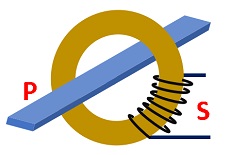
As it is a big article, the content of the post is given below
Why high voltage in open circuit CT Transformer (as per theory)
In the electrical current transformer, the electric current in the secondary is proportional to the primary current.
The voltage across the output (across the secondary winding) will be equal to the multiplication of the electric current in the secondary and the resistor value.
VS = IS x RL
In the above formula,
- VS is the voltage across the secondary winding
- IS is the current in the secondary winding
- And “RL” is the load resistance across the secondary winding of the CT
So higher the load resistance value, the higher the voltage across the secondary winding.
The open circuit in the secondary is equal to a very high resistive load.
So very high voltage will develop across the open circuit of the secondary winding of the transformer.
But this is just a theoretical concept, as few other factors come in during the manufacturing of the CT.
CT transformer with the open circuit – a fact
If we keep the secondary of the CT transformer open, then very high voltage may come across the secondary winding. But this concept is theoretical only.
There are two voltage limiting factors that limit the voltage across the secondary of the open circuit CT.
The 1st reason is due to manufacturing processes and the 2nd reason is due to the real-life applications.
Open circuit voltage limit due to the manufacturing
The voltage across the open circuit CT transformer is limited due to the manufacturing process as follows.
We require a very high flux level in the core for a very high voltage to develop.
And the high flux level requires a core with a big size cross-sectional area.
However, the core size in the transformer is almost always just sufficient for the flux under normal operating conditions. This is to reduce the size, weight, and cost of the transformer.
As the core area of the transformer is limited, so the core of the CT will saturate in case of high flux. Then the voltage will not induce in the secondary winding.
When the current flows in the primary in the open circuit CT, then the voltage will increase 1st quite fast due to the high rate of change of the flux.
This is due to the fact that the induced emf is proportional to the rate of change of flux also. And full primary current will behave as a magnetizing current. Then finally core will saturate. So we may see a spike-type high voltage peak.
(This high dVS/dt was also observed by us during the testing of the transformer as per figure 5 explained later in this article. Our load (active load not just resistor) in the other two windings was such that sometimes, all windings become open type. But our core was not saturating because of the voltage limiting circuit.)
So the voltage at the secondary is always limited in open circuit conditions in CT transformer. This is because of the limited size of the core area, and so limited workable flux in the core.
Open circuit voltage limit due to application
If the secondary is open, then the only primary has the electric current. This current is responsible for the flux in the core.
So, If the secondary winding is an open circuit in the CT transformer, then the CT transformer behaves like an inductor. Refer to figure 1.

This is due to the fact that a coil over a core is like an inductor.
“In fact, all transformers with open circuit secondary are nothing but an inductor. But the value of the inductance will depend upon the type of transformer”.
Electrical equivalent circuit with open circuit CT
As discussed above, a CT with an open secondary behaves like an inductor.
And the value of inductance of this inductor (of the CT equivalent) depends upon the number of turns of primary and the size and material of the core.
Now CT is always connected in a series of loads. So open circuit CT is nothing but an inductor in a series of a load. Refer to figure 2.
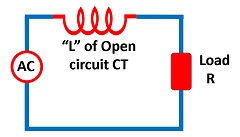
In figure 2, if the load current is less, then the voltage across the inductor will be less.
However, if the current is very high due to the small value of the load resistor R, the heavy flux in the core will generate and the core of the CT will saturate.
So the voltage across the primary (across two terminals of the equivalent inductor) will depend upon the load current and inductor value.
Hence, voltage is always limited across the inductor (primary of the CT).
This kind of voltage limiting is more useful in low-voltage and low-current circuits.
If the voltage across the primary is limited, then as per voltage ratio and turns ratio law, the voltage across the open circuit secondary is also will be limited.
So depending on the load condition and CT construction, the voltage across open secondary is limited.
However, it does not mean that we are free to take risk of the high voltage in an open circuit considering the above two voltage limiting factors in the open circuit CT transformer. I gave an explanation only to understand the concept, and not for taking the risks.
If you want to learn more, then you should try to simulate the above condition in some simulation software like EMTP, MATLAB, or some other simulation software.
How to use CT transformer of open secondary
As discussed above, the voltage across open secondary is high and limited by two factors. But this limited high voltage is just to protect the transformer. And CT will not work properly in such conditions.
Now I will explain the concept of how an open circuit in the secondary of the current transformer remains safe under certain conditions for normal operation also.
Current transformer with two secondary windings
This explanation is as per the use of the CT transformer with one of the winding open in secondaries, in our few projects.
Refer to figure 3. This CT is of bar type. So the number of primary turns is equal to one. But it has two secondary windings.
Now, suppose, the CT ratio is 100/1 for each winding. So we have two secondaries each with 100 turns.
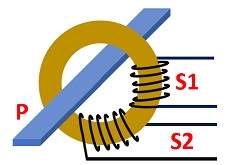
Remember that a CT transformer is also a transformer and follows the rules and formula of turn ratio equal to the voltage ratio.
And also the number of turns of the two secondary windings is equal in the above example.
As both secondary windings have a common core, so flux passing through both winding is also equal.
So if the number of turns and the flux is equal in the two windings of the transformer then the voltage across windings also will be equal.
So if we can limit the voltage in one secondary winding, then the voltage across other open secondary winding also will be limited.
Calculation of the secondary voltage
Now refer to figure 4. Suppose the electric current in the primary is 100 amperes.
As CT ratio is 100/1 for each winding. So one amp current can flow in normal conditions in the secondary.
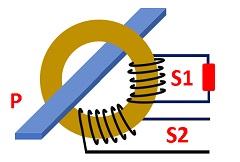
We have connected a load resistor in only one winding S1. While another secondary winding S2 still has an open circuit.
Now suppose the value of the resistor connected across the secondary S1 is 10 ohms.
So the voltage across the secondary winding S1 will be equal to
VS1 = 1 X 10 = 10 volts
Now as turns in S1 and S2 are equal, and also flux, so the voltage across S2 will be equal to S1.
So the voltage across open circuit winding of the CT transformer here will be just 10 volts.
Further, if the turns of S1 and S2 are not equal. For example, if turns in the S2 are double the turns in S1, then we will get 20 volts across the S2 winding.
So, in this case, the open circuit winding S2 will not have any high voltage, and this winding can be kept open safely.
“We can use the open circuit current transformer (CT) with an open secondary if it has two or more secondary windings and one of them has a normal load at the output.“
Current transformer open secondary example as per experience
This is a very special application of the CT with open winding in one of our projects.
Refer to Figure 5. The CT transformer has one primary winding in the figure. This is for explanation purposes only in this article. Our CT was bar type without any primary at all.
A single bar in the primary acts as a primary winding of a single turn. All calculations should be done considering one turn in the primary winding.
This CT transformer has three secondary windings. And the 1st secondary winding has an open circuit.
One of the secondary winding (third winding in figure 3) has the load across this. But in our case, this load was not a simple resistor, but it was a dynamic load consisting of capacitors, resistors, transistors, gates, and op-amps.
So the load is not fixed in the 3rd winding.
The 2nd secondary winding (middle secondary winding in figure 5) has a control circuit to limit the voltage across this winding.
So the maximum voltage across this winding is always limited by the electronics in this voltage limiter circuit (in the middle winding). And this load also was also not fixed.
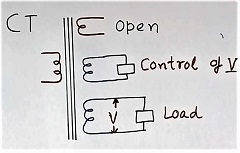
Once the voltage in this winding is limited, the voltage in the other windings always follows the turn ratio and voltage ratio rule. Even if no load across the winding.
The first winding in the secondary in Figure 3 has no load across it. But as the voltage is limited in this open winding as per the turn ratio and voltage ratio formula. So no over-voltage will come.
If turns are not equal in all secondary windings, then also concept will work. But the voltage across different secondary winding will depend on the turns ratio.
In fact, a small voltage control in one winding with fewer turns can control the high voltage across another winding with more turns.
Extra knowledge as per experience
I have discussed the application of one special transformer with an open circuit in one of the three windings of the CT transformer.
However, we had many difficulties in designing the above transformer at the initial stage.
It was difficult to do calculations for the core size, the number of turns in all the windings, and also the size of the copper conductors in the windings. (We were not the transformer manufacturer, but just the user of the transformer).
This is because the control winding (2nd in figure 5) did not have a simple resistive load. It has a current spike-type load using thyristors.
So typical calculation as per the normal formula of flux value was not working. And the calculations became quite complex.
A core with a large cross-sectional area was required to make it work.
The size of the transformer core became more than 10 times compare to the size of the core for the fixed resistive load of the same power.
And the transformer also became very big and expensive.
If you like to watch a video then watch the video link below. It has starting point only at the open secondary in a three-winding CT.
Further, read the CT and PT transformer difference
Also, read How current Transformer works
Further, read the article What is a potential transformer for more knowledge on transformers.
Read what is MOV varistor
Further, read Why and how power factor correction?
If so, then subscribe to my YouTube channel.
About the author – G K Agrawal B.Sc and B.Tech (from HBTU Kanpur), Retd. Sr DGM Design (BHEL), the inventor of patents, has lifelong industry experience in the electrical and electronics design field of R&D. He worked for BHEL. He shares his experience and knowledge on blogs and YouTube. Read the profile here.

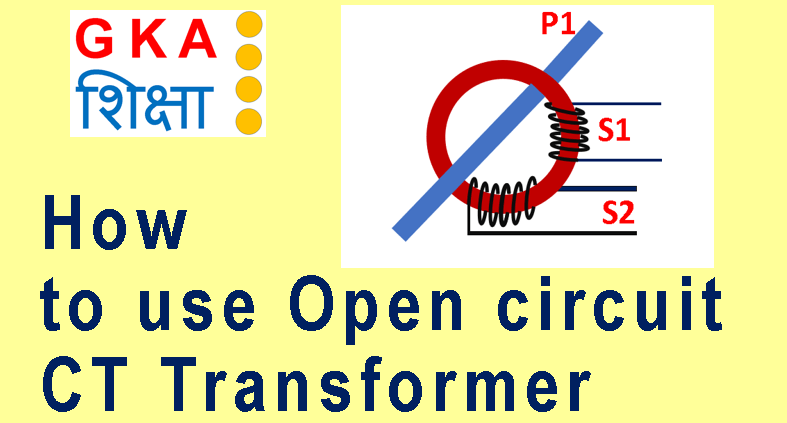

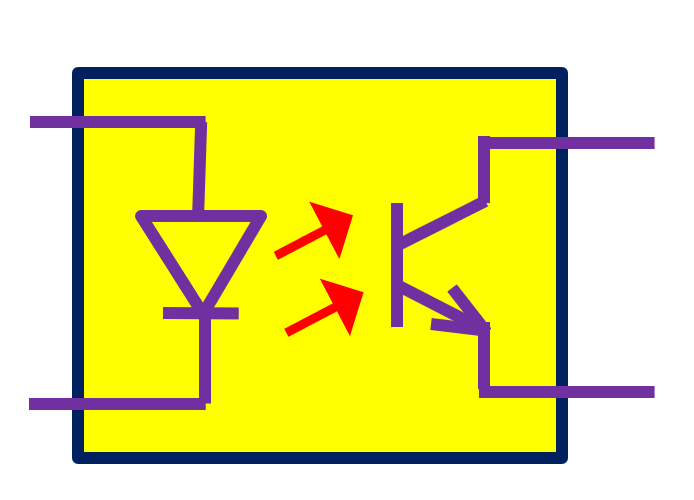
High CT secondary voltage of an open circuit CT is not really theoretical.
If there are only two secondary terminals on the CT, you must never leave them open circuit.
Since the CT must obey ampere.turns balance, the ONLY place that the current can flow is through the excitation path. We test the excitation path as the Magnetising Curve or Excitation Curve … you can see above kneepoint the current and the voltage keeps increasing because the CT is trying to develop enough voltage to force current through an infinite impedance .. eventually that voltage will cause a BANG!
If you have three or more terminals on the secondary, you should only connect devices to one PAIR of terminals, all others left disconnected (open circuit). This is because the CT satisfies ampere.turn balance and volts/turn balance
ampere.turns means that the sum of Iprimary x tprimary must equal the sum of the ampere.turns of all the secondary windings
SO with a burden connected across one pair of terminals, a certain voltage will be developed according to Ohm’s Law V=IZ,
You therefore get a certain voltage across the other pairs of terminals and therefore current flows there also based on Ohm’s Law I=V/Z
SO you can see that the primary current ampere.turns is balanced by (Isecondary1.turns1) + (Isecondary2.turnssecondary 2) so the ratio you get out is dependant on the size of the respective burdens
Very exclusive explanation
Pingback: What is the Snubber circuit and its applications in power electronics - G K Agrawal
Pingback: Why is the electrical transformer rating is in KVA - G K Agrawal